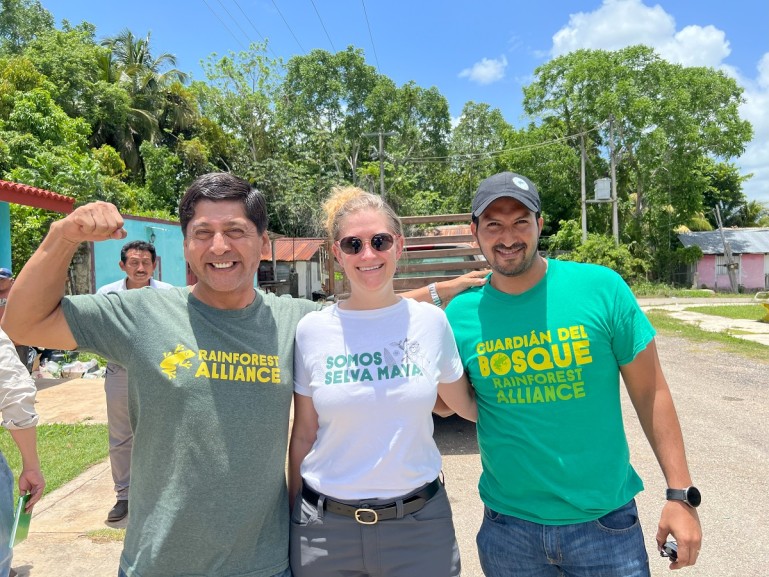Link(s) :


30.06.2023
As part of its policy of integrating Latin American forests, and in the wake of the Rainforest Alliance article in our newsletter of May 12, the ATIBT, along with two of its members, the Probos Foundation and Precious Woods, took part in the trade mission organized by the Rainforest Alliance in Central America.

Organized by Carlos Estrada and the Rainforest Alliance team from Mexico and Guatemala, the main objective of the "Selva Maya Tropical Timber Business 2023" in Tulum on June 15 and 16 was to find ways of improving the marketing of timber from Mexico's certified community forests. Before setting off for several days in the field, many intense and constructive discussions took place with around a hundred people from all sectors and a wide panel of representatives from the Ejidos, the name given to Mexico's community forests.
 Selva Maya Tropical Timber Business Forum 2023 © B. Jobbé-Duval
Selva Maya Tropical Timber Business Forum 2023 © B. Jobbé-Duval
 Selva Maya Tropical Timber Business Forum 2023 © B. Jobbé-Duval
Selva Maya Tropical Timber Business Forum 2023 © B. Jobbé-Duval

Selva Maya Tropical Timber Business Forum 2023 © B. Jobbé-Duval
Following this meeting, a 10-day visit to the various community forests located in the Mexican and Guatemalan parts of the Selva Maya gave rise to observations and recommendations that are briefly summarized below.
Several observations can be made at the outset. Firstly, it is noteworthy that tropical woods do not seem to raise any image concerns in Central and North America, unlike in Europe, where they are often the subject of criticism due to concerns linked to deforestation and loss of biodiversity in the regions of origin, as well as problems of governance and legality of logging in certain producer countries, or the rights of indigenous peoples.
Nor do CITES listings seem to raise concerns about the image of Appendix II-listed timber. In Mexico, the main obstacle lies in administrative procedures, with excessively long delays to obtain CITES export permits (sometimes up to 6 months), whereas in Guatemala, a week is enough.
The issue of the new European regulation on deforestation was also raised. It was concluded that there is no short-term urgency, given that its implementation is scheduled in 18 months' time, and that certified timber will, as in Central Africa, have little difficulty in being sold on the European market. Ejido Petcacab, Yucatán, Mexico © B. Jobbé-Duval
Ejido Petcacab, Yucatán, Mexico © B. Jobbé-Duval
 Ejido Petcacab, Yucatán, Mexico © B. Jobbé-Duval
Ejido Petcacab, Yucatán, Mexico © B. Jobbé-Duval
A number of general recommendations were made to guide future actions. Firstly, it is vital to maintain close contact between all players, particularly on sensitive issues such as CITES, the image of tropical woods in Europe and the issue of intact forest landscapes (IFL), which also concerns the Selva Maya forests. A regional association could be set up, bringing together the main players concerned. The unity and exchange of information within this association would be essential to collectively defend the interests of these remarkable players.
Who really knows the woods of this region? It would also make sense to develop a powerful marketing strategy around the "Bois de la Selva Maya" brand. This brand has considerable potential and a positive connotation due to its link with a region with a prestigious and deeply-rooted cultural identity.
In fact, the region's woods have many uses:
The most sought-after species are mahogany (Swietenia macrophylla), pucté (Bucida buceras), chicozapote (Manilkara zapota), katalox (Swartzia cubensis), tzalam (Lysiloma latisiliquum), and the impressive ciricote (Cordia dodecandra), among others... Ejido Petcacab, Yucatán, Mexico © B. Jobbé-Duval
Ejido Petcacab, Yucatán, Mexico © B. Jobbé-Duval
 Forest community Uaxactun, Peten, Guatemala © B. Jobbé-Duval
Forest community Uaxactun, Peten, Guatemala © B. Jobbé-Duval
Throughout the region, the promotion and development of lesser-known species is central to the industry's future.
Specific recommendations for Mexico were also made. First of all, it is crucial to consider the Mexican domestic market as a priority due to its size and dynamism, notably linked to the intensive development of tourism in the Yucatan peninsula. A national market survey should be carried out to identify the main users of tropical woods and draw up a precise map.
To support the activities of the "Ejidos" (Mexico's community forests), sustained commercial accompaniment, in continuity with what the Rainforest Alliance has already undertaken, would be beneficial. It is important to provide ongoing support in this area. It should be noted that the "Ejidos" are not always well prepared to welcome foreign customers. It is also advisable to explore export opportunities, even on a small scale, to diversify outlets and open up new horizons for Mexican forest products.
Specific recommendations were also made for Guatemala. Given that the domestic market does not offer the same potential as in Mexico, exports must remain the main outlet to be considered.
In order to secure markets and promote lesser-known species, it is essential to put in place a solid communications policy based on three pillars. Firstly, a sound knowledge of the forest resource is required. Secondly, it is important to correctly characterize the species in order to highlight their specific qualities. Finally, effective marketing must be developed to enhance the value of the Selva Maya's "lesser-known" woods.
As export markets are sensitive to image issues, proactive communication is crucial to ensure that these outlets are not compromised. Particular attention must be paid to preserving the positive image of Guatemalan forest products.
It should be noted that Belize is also part of the Selva Maya, but the tour did not cover activities in this country. Forest community present their timber species © B. Jobbé-Duval
Forest community present their timber species © B. Jobbé-Duval
 Forest community present their timber species © B. Jobbé-Duval
Forest community present their timber species © B. Jobbé-Duval
Find out more about the Selva Maya timber catalog, recently produced by the Rainforest Alliance
In addition, the Mexican government has published the following:
https://maderas-comerciales-tropicales.cnf.gob.mx/especies
Link(s) :